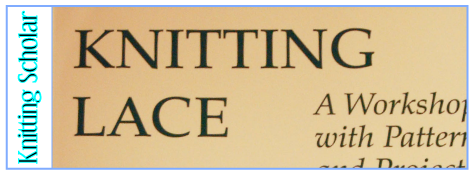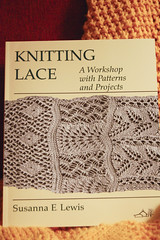First, the facts:
Title: Knitting Lace: A Workshop with Patterns
Author: Susanna E Lewis
Published by: First printing Taunton Press 1992, Current Printing Schoolhouse Press 2009
Pages: 209
Type: How-to.
Chapters:
I. Sampler Patterns
II. A Lace Knitting Workshop
1. Getting Started
2. Exploring the Sampler Patterns
3. Charting Lace Patterns
4. Using Lace Patterns in Garments
The In-Depth Look:
To put it simply, this book is a masterpiece, and that’s not a word I bandy about loosely. Recently reprinted by Schoolhouse Press, this is the story of Susanna Lewis’ classic recreation of a 19th century lace sampler for the Brooklyn Museum. She says in the introduction, “My job was to figure out how all the patterns were made. I started the project with great confidence, as I was a skilled hand knitter and had been knitting lace for many years, following complicated patterns in books both old and new. But I soon discovered how little I really knew about the principles of lace knitting and about the struture of lace. I had been knitting lace, but I didn’t know much about lace.”
The book starts quite simply–with the 92 lace patterns that make up the sampler–with each stitch charted and spelled out line-by-line. This alone makes the book interesting and worthwhile, but that’s just the start.
It’s part 2 that’s going to knock your handknit socks off. In the second half, the author takes everything she learned from charting all those lace patterns and shares it with you. Just knowing how to follow a lace pattern and knit it is not the same as understanding it,She explores what makes knitted lace in the first place, the motifs you can expect, how increases and decreases balance each other and add shape. There can be medallions of patterns or long, vertical edgings, and the only thing limiting you is your imagination. Like anything else, once you know the mechanics, you can do anything.
I’ve only recently gotten a copy of this book, and need to go back and study, well, the entire second half in depth, because a quick read is ultimately unsatisfying–like thinking you understand the “William Tell Overture” because you’ve heard the Lone Ranger theme. There is a TON of information in here, but it’s information that’s easily grasped because Susanna Lewis explains it so well. It’s amazing–not only as a piece of scholarship from charting that original lace sampler, but for all the lessons learned from it.
Of course, that’s the point about a sampler in the first place. The original stitcher uses it as a record of things she has learned, whether it’s embroidery stitches, knitting stitches, or mending techniques. It’s her own personal record of progress, and also a reference to use later on. By recreating this 19th century sampler, Susanna Lewis has done exactly that–used it as a reference, but also as a learning experience. The book just shares it with the rest of us.
There’s a reason this out-of-print book was selling for hundreds of dollars, but thanks to Schoolhouse Press, it’s back in print. Want to see it yourself? You can get a copy from Amazon.com.
Want to see bigger pictures? Click here.




Comments on this entry are closed.
I ordered this book recently and agree with you. I have to spend more time with the second half. I would love to see the original piece. With Crazy Lace, this book, and the new Vogue Lace Stitches book, I’m really branching out in my exploration of lace knitting and loving it.
Yes, I’m sure the original is AMAZING. I’d love to see it!
Does a download version available for this book? It seems great to me.
Not that I know of. I’d ask Schoolhouse Press if an e-version is in the works.